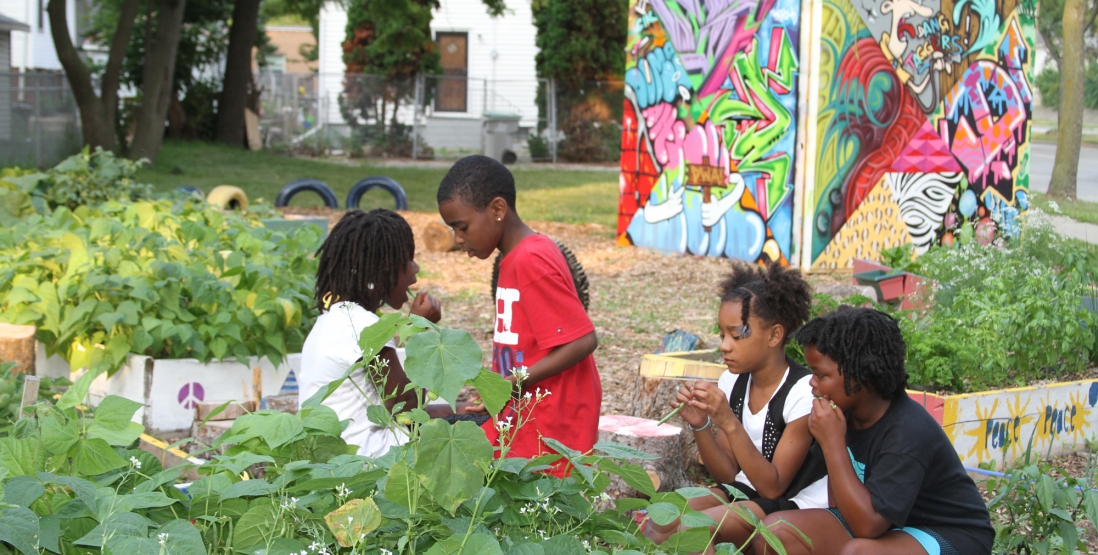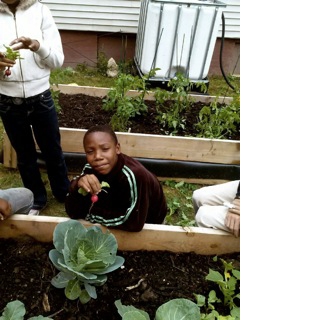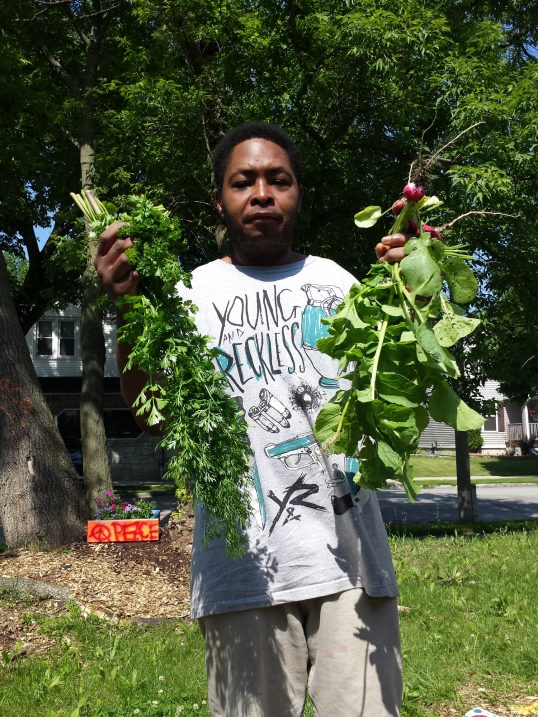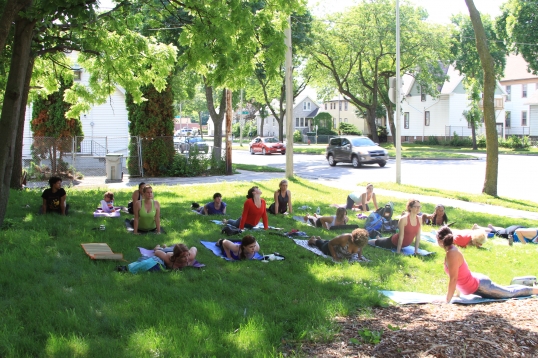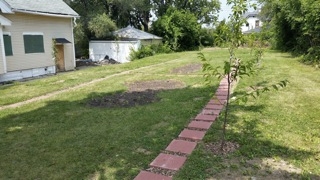Farming the Revolution
Peace Park, 5th Street and Locust Street, Milwaukee, Wisconsin.
Photograph courtesy of thepeacepark.com.The recent police killing of Dontre Hamilton, an unarmed African-American man, has reminded the nation of the race-based problems that have plagued the city of Milwaukee for over fifty years. Known as the “Selma of the North” throughout the turmoil of the 1960s, the city has been hit hard by such developments as white flight and deindustrialization, developments that have had a profound impact on Milwaukee’s built environment. Abandoned industrial structures, vacant lots, and foreclosed homes dot the landscape of many of the city’s predominantly African-American neighborhoods.
Yet, many within the city have begun grassroots efforts to address such environments. More specifically, Milwaukee has seen a number of young African-American activists turn to urban agriculture and community gardens as ways to reclaim such previously neglected spaces. Michael Carriere, an associate professor of history at the Milwaukee School of Engineering, recently sat down with two such activists, Fidel Verdin and Antoine Carter, to discuss the intersection of race and urban agriculture, as well as their efforts to transform Milwaukee into a more livable, more equitable city for all its citizens. Verdin, a Milwaukee-based artist and educator, is the developer of Peace Park, a community garden located at 5th Street and Locust Street. Carter is the program manager at Milwaukee Urban Gardens (MUG), a nonprofit organization that helps both individuals and organizations establish community gardens—and then provides training for those who want to tend these gardens.
A participant in MUG’s Young Farmer program.
Photograph by Antoine Carter.
Michael Carriere: Fidel, how have issues of race informed your work in urban agriculture? Did you view your work on Peace Park, for example, through the lens of race in any way?
Fidel Verdin: To me, the premise of anything urban is black. You can’t take race out of it if you’re saying “urban.” It’s a black city. So when we talk about urban anything, that’s what we’re talking about. You can’t take race out of it, unless you’re being slick. [laughs]
MC: And what about you, Antoine? What is the relationship between race and the work you do with Milwaukee Urban Gardens?
Antoine Carter: The majority of MUG’s gardens are in the urban part of the city. It’s in the heart of the city, which is—based on the way we are in Milwaukee—mostly black. And so working with MUG I’ve seen that, in the past, there was this sort of resistance against MUG, just because they didn’t know if they were elitist or coming in [to the neighborhood] in a sort of parachuting mode. But as far as this year is concerned, I really see the tie-in is just that people are sick of wasted space, just tired of looking at the same vacant lots over and over again—with no form of development coming. What I find in my work is that, of the five senses, the one that you instantly use is sight. People talking about systems [political, economic, judicial], that’s all stuff you can’t see. I think, in the neighborhoods we work in, changing that first sense—that sense of sight—in what you see, I think that works really well. It’s a problem that most people in these neighborhoods are people of color—they have that issue with what they’re seeing.
MC: Yes–disinvestment in these neighborhoods does impact neighborhoods of color disproportionately. So would it make more sense to talk about things like urban agriculture and community gardening in relation to civil rights? Or should we think about such spaces as means to bring about alternative forms of both economic development and political engagement?
AC: Not in all the gardens, but in a lot of gardens they are tied into neighborhood associations. It’s a weird partnership, but it goes really well together, because garden leaders become community organizers. The same person that’s coming to just get involved with the garden, at some point, from gardens you have to go to a neighborhood association meeting. And that’s where you learn about what’s happening in your neighborhood, what’s getting improved—and what’s not. It forces you to continue to go to those meetings and continue to be involved …. The more and more you think about it, people become empowered. Not only do they want to change this particular lot or the way they eat, they want to change everything they see in their neighborhood. I view it as a really safe step, one that leads you to really grandiose things.
FV: That’s really a good way to put it. When people take ownership, whether it’s by renegade ways or through the proper channels, when they take that ownership they start to become advocates by default. People begin to understand the stake they have in their communities. So then you start adding things up: Where are the resources at? Where are the resources going? And then, naturally, if you’re talking about gardening, you’re talking about food. And then there’s a conversation about food deserts. It becomes an exposé of all these systems, and the next thing you know, you start to see the vacant lots and disparities in general—it’s not just about the empty lots. Businesses are empty; houses are boarded up. And it’s only happening in a designated area. It’s not all over the city. There are vacant lots in a certain space. This is the same shit my pops was talking about years ago. So how does it stay in one area, in one space for 30 years? That’s from the top-down, that’s institutional, keeping resources in one area—and keeping them out of another area. Once people start figuring this out and adding things up, they’ll start trying to take these resources. And then people start looking at the survival mode of it. A lot of people in this environment are really in hand-to-mouth survival mode. So they start looking at this as a survival mechanism. Then other people see it and they start coming to it. I’ve experienced it on 5th Street. People come and you almost feel sorry for them. They really are coming for little vegetables here and there. It’s real.
Harvest time at Peace Park.
Photograph courtesy of thepeacepark.com.
AC: I think people are getting more and more tired of living like that. The past couple months have been really crazy. From what I see, people are just looking to take ownership, and so it will be really interesting to see what 2015 brings. There’s this feeling that people are tired of feeling hopeless, and they want to figure this out and get things done.
MC: So can such projects begin to counter these legacies of deindustrialization and disinvestment? How, in other words, will these projects ultimately look? And perhaps more importantly, how will they ultimately physically transform these communities throughout the city?
AC: People want to do way more than just grow food on these lots, ranging from the Peace Park, where you’re incorporating art and hip hop, to ways of changing the ways people think about what they want to see on that particular block. When we did that yoga, it was crazy—we could have broken the Internet. [laugh] People were stopping and waving and honking.
Yoga at Peace Park, Summer 2014.
Photograph courtesy of thepeacepark.com.
FV: On a physical level, there are a lot of ways to gather people, to galvanize people in these spaces. To get people active in these spaces, using them as community activation sites. And they also become ways to educate young people to break the cycles. You get young people involved, hands on, early, and they’ll have different options. So then you won’t have the same cycles of things going on. Now, I’m thinking about how you turn it into an enterprise for a community or a block club. How do you generate resources? How do you create financial stability for something that everyone needs? Food, flowers, vegetables, whatever. For young people, you’re talking about the same money that’s not coming to them by other means, and then going out of their community.
AC: And that’s the next step. That’s really the next step. And urban ag[riculture] isn’t what people think it is. It’s not a bunch of hipster white people [laughs]; it’s not a bunch of old black ladies. It’s changing. For every white lady, there’s a Fidel who’s really cool and the Fidels in urban ag[riculture] are going to get the young people.
MC: We’re having this conversation in the immediate aftermath of the Milwaukee County district attorney deciding not to file charges against Christopher Manney, a white police officer, in the shooting death of Dontre Hamilton, an unarmed African-American man. Sadly, this is only the latest incident in a city that has a long history of police misconduct—and it’s playing out as other cities are coping with the deaths of people of color like Michael Brown, Eric Garner, and Tamir Rice. You’ve been talking about urban agriculture as a way to effectively heal spaces damaged by disinvestment. Can these spaces also begin to heal people affected by such violence?
Reggie’s Orchard, Milwaukee, Wisconsin.
Photograph by Antoine Carter.
FV: The healing and the therapy are so necessary. They really are. It’s really necessary on a big scale. You mention the Garner case. It’s a national thing going on right now, and young people are paying attention. And really there’s no answer to the equation. For many young people, no one’s really explaining this shit. No one’s offering any sort of therapy or protection or love. It’s crazy, and we probably won’t see the effects of this for years. At the same time, these episodes drive home the fact that we are so disconnected from our traditions, from our folkways. Those are the things we did down south: The land was a healer; the land is therapy. Part of our tradition as well is that we honor our ancestors, we honor those who are no longer with us, physically, by keeping their memory alive. That’s part of what we do, and part of what we’ve always done. Being able to use community spaces to do that is healing for everyone. I’ve been thinking of these spaces as almost like a retreat thing. How do we escape right in the ‘hood, right there, right next to the terror shop, the 5th District [Milwaukee police headquarters]. How do we create a safe space that people know about? The same way people call protests at certain spaces, you call a meeting at the Peace Park or at the orchard. People just know that this is community-owned space, this is ours—and if people want to bring their babies there on Sunday, they just know that. There’s so much possibility and creativity possible in fusing the activism, if you will, the civil rights, the human rights—whatever you want to call it—with urban ag. ‘Cause there ain’t no culture without agriculture. [laughs]
MC: Both of you have continued to reference the concept of “ownership.” The word ownership can mean many things to many people—how are you both using it? Do you want those taking part in these projects to actually own the land they are working?
AC: Oh, yeah. We do own a few lots—that’s the end goal of a successful garden. But we also want to get our gardeners as much ownership, as much control, over the project in terms of which direction it goes. I first want to give the community as much control over that as possible. Then we’ll work to get them the land. You can’t have one without the other.
FV: And there are different understandings of ownership now. I think that’s the natural progression of the era in which we’re living, the information age if you will, the independence age if you will, where people can create something out of nothing and own it. You don’t necessarily have to go through traditional methods of owning stuff anymore. And young people are more acclimated to entrepreneurship and different ideas of ownership and things like that now. I think the idea of people claiming their own independence will bring some of this about. And that could be in neighborhoods, or organizations—not just on the individual level.
MC: Those evolving understandings of ownership are fascinating, but—bottom line—do you worry that the city one day might want some of these lots back? Or are there strategies in place that make your work more sustainable than past grassroots campaigns to change the landscape of the city? How do you work with city officials to make actual ownership of these projects a reality? Antoine, I believe that MUG operates as a land trust—is that the answer here?
AC: Yes! MUG is a land trust, and our goal when we initially begin planning with a group is to select a location that is approved for long-term planning for the garden. Groups are able to go from seasonal permits that run from April through November, with the potential then for a three-year lease. We can eventually purchase a lot for the sole purpose of community gardening. This is some of the front work I do with the city.
FV: As a community park and garden “place maker” that is a very relevant question. I think the city of Milwaukee seems to have a good system in place to facilitate an ownership transfer after a good standing and lot maintenance has been established. That’s another reason to keep good relationships with city council members and neighborhood stakeholders. Getting the city officials actually involved from the beginning of planning our projects and helping with resources for the building process is the goal. We want the city invested in itself and to see our long-term vision.
MC: As leaders of a “Rust-Belt” city, I think political leaders in Milwaukee are aware that we have to try new things, as the era of mid-twentieth century industrial security is not coming back. So should we see urban agriculture and community gardening as responses to the perceived breakdown of certain ideas and institutions previously seen as immutable? The financial crisis called into question certain beliefs related to homeownership, for example, while these recent police brutality cases suggest that our judicial system is broken. Are the projects we’re seeing in Milwaukee responses to this atmosphere of crisis?
FV: No doubt. But there’s also opportunity there. It’s like a clean slate—what are we going to do now? This is the wave of the future. It’s also our past, but it is our future.
AC: And it’s pretty rebellious, too, at the same time.
FV: Totally. It’s one of the most revolutionary things you can do in this environment, and to get our people to understand that. It’s a form of protest, if you will. It’s a form of uprising. It’s all that.
For more on Fidel Verdin’s work at Peace Park & Garden, visit www.thepeacepark.com. For more on MUG, see www.groundworkmke.org.
✓ Not peer-reviewed
Mike Carriere, Antoine Carter, and Fidel Verdin, “Farming the Revolution,” Aggregate 3 (March 2015), https://doi.org/10.53965/MOWH4714.
